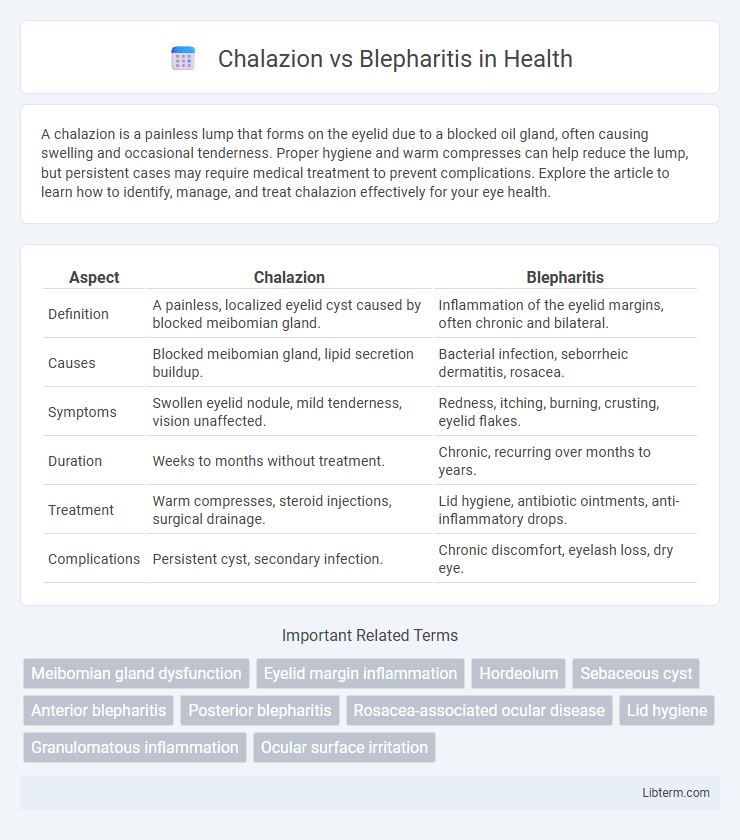A chalazion is a painless lump that forms on the eyelid due to a blocked oil gland, often causing swelling and occasional tenderness. Proper hygiene and warm compresses can help reduce the lump, but persistent cases may require medical treatment to prevent complications. Explore the article to learn how to identify, manage, and treat chalazion effectively for your eye health.
Table of Comparison
| Aspect | Chalazion | Blepharitis |
|---|---|---|
| Definition | A painless, localized eyelid cyst caused by blocked meibomian gland. | Inflammation of the eyelid margins, often chronic and bilateral. |
| Causes | Blocked meibomian gland, lipid secretion buildup. | Bacterial infection, seborrheic dermatitis, rosacea. |
| Symptoms | Swollen eyelid nodule, mild tenderness, vision unaffected. | Redness, itching, burning, crusting, eyelid flakes. |
| Duration | Weeks to months without treatment. | Chronic, recurring over months to years. |
| Treatment | Warm compresses, steroid injections, surgical drainage. | Lid hygiene, antibiotic ointments, anti-inflammatory drops. |
| Complications | Persistent cyst, secondary infection. | Chronic discomfort, eyelash loss, dry eye. |
Introduction to Chalazion and Blepharitis
Chalazion is a localized, painless eyelid swelling caused by the obstruction of Meibomian glands, leading to cyst-like inflammation. Blepharitis refers to chronic inflammation of the eyelid margins, often associated with bacterial infection and dysfunction of the oil glands, resulting in redness, irritation, and crusting. Both conditions affect eyelid health but differ in etiology, clinical presentation, and management strategies.
Understanding Chalazion: Causes and Risk Factors
Chalazion forms when a meibomian gland in the eyelid becomes blocked, leading to inflammation and a painless lump. Risk factors include chronic blepharitis, rosacea, and poor eyelid hygiene, which increase the likelihood of gland obstruction. Understanding these causes aids in differentiating chalazion from blepharitis, as the latter primarily involves eyelid margin inflammation and infection.
Blepharitis Overview: Triggers and Prevalence
Blepharitis is a common chronic inflammation of the eyelid margins primarily triggered by bacterial overgrowth, seborrheic dermatitis, and dysfunction of the Meibomian glands. It affects individuals of all ages, with prevalence rates estimated to be as high as 47% in clinical populations. Environmental factors such as allergens and poor eyelid hygiene also contribute significantly to exacerbations and persistent symptoms.
Key Differences Between Chalazion and Blepharitis
Chalazion is a localized, painless eyelid cyst caused by obstruction of Meibomian glands, while blepharitis is a chronic inflammation of the eyelid margins often linked to bacterial infection or skin conditions like rosacea. Chalazion typically presents as a firm, non-tender lump, whereas blepharitis manifests with redness, swelling, and crusting around the eyelashes. Treatment for chalazion usually involves warm compresses and sometimes minor surgery, contrasting with blepharitis management that focuses on eyelid hygiene and antibiotic therapy.
Signs and Symptoms Comparison
Chalazion typically presents as a painless, localized swelling or lump on the eyelid caused by blocked meibomian glands, often with mild redness but minimal tenderness. Blepharitis exhibits symptoms including redness, itching, burning sensation, crusting at the eyelid margins, and possible eyelash loss, reflecting inflammation of the eyelid edges. While chalazion manifests as a distinct lump, blepharitis affects the entire eyelid margin and may cause chronic irritation and flaky debris.
Diagnostic Methods for Chalazion vs Blepharitis
Chalazion diagnosis primarily relies on clinical examination revealing a painless, localized eyelid lump due to blocked Meibomian glands, often confirmed through slit-lamp biomicroscopy. Blepharitis diagnosis involves identifying eyelid margin inflammation with redness, scaling, and crusting, supported by eyelash sampling and microscopic analysis to detect bacterial colonization or Demodex mites. Distinguishing between chalazion and blepharitis depends on detailed patient history and specific signs observed during ophthalmic evaluation.
Effective Treatment Options
Chalazion treatment often involves warm compresses to promote drainage, along with antibiotic or steroid eye drops for inflammation reduction. Blepharitis management includes meticulous eyelid hygiene using lid scrubs, artificial tears, and antibiotic ointments to control bacterial growth. In refractory cases of both conditions, minor surgical intervention or corticosteroid injections may be necessary to resolve persistent symptoms effectively.
Prevention Tips for Eyelid Health
Maintaining proper eyelid hygiene by regularly cleaning the eyelid margins with a gentle cleanser helps prevent both chalazion and blepharitis. Avoiding eye makeup contamination and not sharing towels reduce the risk of bacterial buildup that contributes to inflammation and blocked glands. Applying warm compresses daily can improve oil gland function, minimizing the chances of developing these common eyelid conditions.
When to Seek Medical Attention
Seek medical attention for a chalazion if it persists beyond two weeks, becomes increasingly painful, or impairs vision, as these symptoms may indicate infection or complications. In cases of blepharitis, consult a healthcare provider if symptoms worsen despite good eyelid hygiene, cause significant discomfort, or lead to eyelash loss or changes in eyelid appearance. Prompt evaluation ensures accurate diagnosis and appropriate treatment to prevent chronic issues or vision impairment.
Frequently Asked Questions
Chalazion and blepharitis are common eyelid conditions often confused due to similar symptoms like swelling and redness. Chalazion is a painless lump caused by blocked oil glands, whereas blepharitis results from inflammation of the eyelid margins, frequently linked to bacterial infection or skin conditions like dandruff. Treatment differs; chalazion may require warm compresses or minor surgery, while blepharitis management focuses on eyelid hygiene and antibiotics.
Chalazion Infographic

 libterm.com
libterm.com